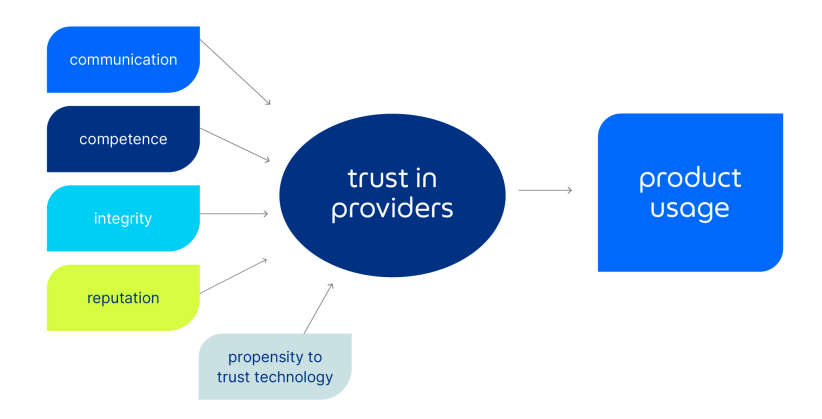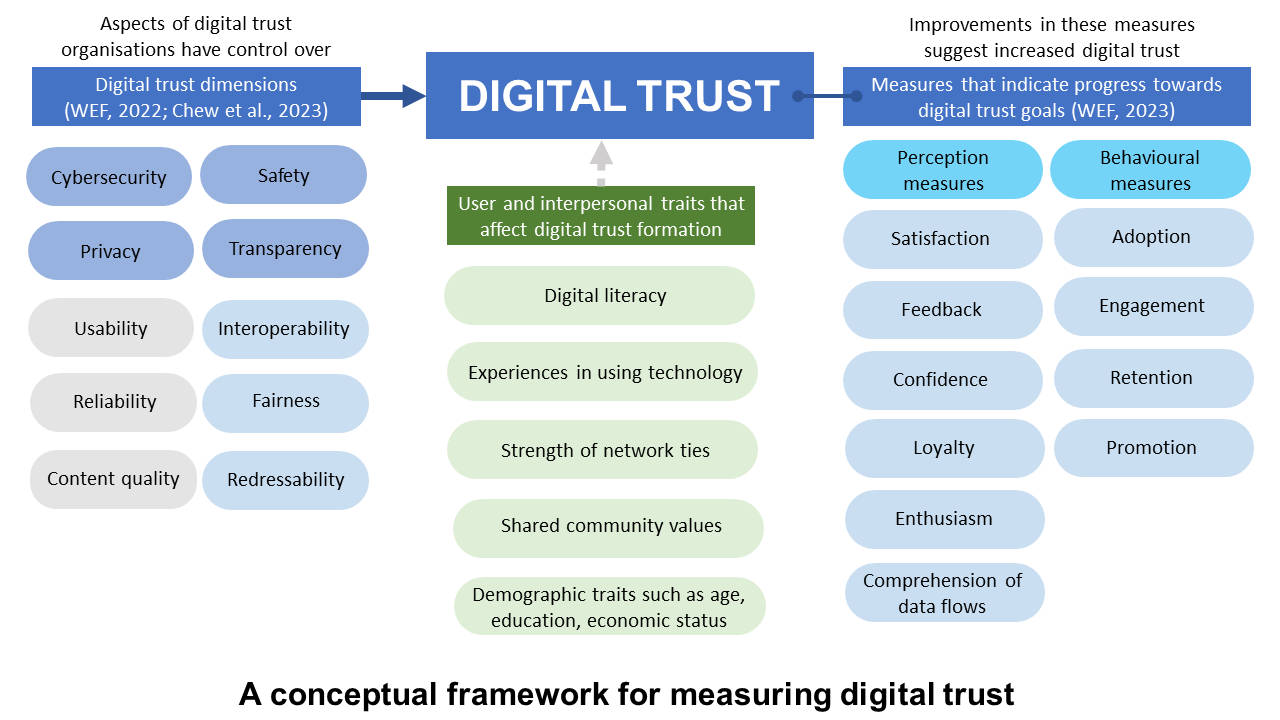
By Dr. Chew Han Ei, Adjunct Senior Research Fellow, Institute of Policy Studies
During the 2023 Singapore International Cyber Week, Senior Minister Teo Chee Hean, Chairman of Singapore’s Smart Nation and Digital Government Group, delivered a keynote address, emphasising the critical need to establish trust in the digital realm. The erosion of trust in the digital domain, caused by online harms such as scams, ransomware, misinformation, and other malicious cyber activities, is rendering the digital world unsafe. Consequently, it discourages users from engaging in online transactions, depriving them of the convenience and time-saving benefits offered by digital services. Furthermore, the economy may lose the productivity gains and growth driven by new digital services.
The World Economic Forum (WEF) has similarly expressed concerns about the current freefall in digital trust and has sought to reverse this trend through its Digital Trust Initiative, which aims to assist leaders in making trustworthy technology decisions. To this end, the WEF published a report titled “Earning Digital Trust: Decision-Making for Trustworthy Technologies,” covering eight dimensions: cybersecurity, safety, transparency, interoperability, auditability, redressability, fairness, and privacy.
Understanding Digital Trust
To effectively navigate the evolving digital landscape, understanding and measuring digital trust is not just an imperative; it is the compass that will guide organisations and policymakers toward an inclusive digital future.
“Digital trust as individuals’ expectation that digital technologies and services – and the organisations providing them – will protect all stakeholders’ interests and uphold societal expectations and values.” – World Economic Forum

Figure 1: Schema of trust model (Tech for Good Institute, 2022)
Digital trust can be further divided into two main components: mechanical and relational trust. Mechanical digital trust refers to the “means and mechanisms that deliver predefined outputs reliably and predictably” and can be evaluated along the WEF dimensions such as cybersecurity, safety, and transparency. On the other hand, relational digital trust is associated with the traditional trust between people, which influences the adoption of digital tools. It encompasses the social norms and expectations associated with using digital tools. This distinction is also highlighted in the report “Digital Trust and Why it Matters.“
For example, research on trust in digital financial services by the Tech for Good Institute demonstrates that winning trust involves not only mechanical competence but also relational trust dimensions such as integrity, communication, and reputation (see Figure 1).
A Conceptual Framework for Measuring Digital Trust
The primary challenge in rebuilding digital trust is the ability to measure it in a universally relevant way. Lord Kelvin’s words are particularly relevant here: “If you cannot measure it, you cannot improve it.” To this end, the WEF recently released a White Paper on Measuring Digital Trust for organisational leaders. It also noted its engagement with the International Organisation for Standardisation (ISO) to further develop measures for supporting digital trust. The remainder of this article discusses a conceptual framework for measuring digital trust, which integrates the WEF dimensions with existing academic research.
Outcome measures of digital trust evaluate the strength of an organisation’s relationship with an actor, whether an individual or an organisation. The WEF recommends collecting both perception measures, such as satisfaction, feedback, confidence, loyalty, enthusiasm, comprehension of data flow, and behavioural measures, such as adoption, engagement, retention, and promotion. Together, these subjective and retrospective outcome measures indicate the level of trust individuals or organisations have toward an entity, with improvements in these measures signifying increased trust.
These outcome measures can be adapted to assess trust in various digital services and technology providers. For instance, the Tech for Good Institute study on digital financial services contextualised digital trust outcome variables that include perception measures such as “digital financial service providers are always honest with their customers” and “given digital financial service providers’ track record, I have no reason to doubt their reliability.” It also included behavioural measures, like the adoption of digital financial services.
The report “Digital Trust and Why it Matters” lists four key dimensions of trustworthy technologies: cybersecurity, safety, privacy, and transparency. It also identifies three dimensions of functionality: usability, reliability, and content quality, along with three emerging dimensions: interoperability, fairness, and redressability. The WEF insights report lists eight such dimensions and notes that these objective measures are indicative of the characteristics that suggest that digital services or technology providers can be trusted. Organisations have control over these dimensions, and measuring these indicators checks if leaders are making decisions that promote digital trustworthiness.
For instance, under the cybersecurity dimension, the WEF recommends measuring incident prevention and incident response, such as predefined goals for recovery point objective and recovery time objective. Measures under the safety dimension include safety training, corrective action, and threat modeling and mitigation. The rest of the measures and dimensions can be found in the White Paper.
Individual and group traits can affect digital trust, although organisations may have less control over these aspects. Group traits include interpersonal dimensions, such as the strength of network ties and shared community values. Individual traits include digital literacy and experience in using technology. Notably, digital literacy emerges as the most consistent driver of digital trust in existing academic literature. It was found to be important in the adoption of digital financial services in the Tech for Good Institute study.
Figure 2 illustrates the conceptual framework for measuring digital trust, outlining the dimensions and outcomes of digital trust, as well as user traits that impact the formation of digital trust.
Figure 2: A conceptual framework for measuring digital trust
Call to Action
Building an inclusive digital future for all requires a deep understanding of trust dynamics in the digital domain. In the ever-evolving digital landscape, the need to measure digital trust is abundantly clear. Trust is a cornerstone of all our digital interactions, from online transactions to social interactions, and is vitally important for the growth of our digital economies. To fully realise the benefits of digitalisation and ensure the security and well-being of citizens, we must, therefore, develop universally applicable methods of measuring and rebuilding digital trust.
Drawing from early work by the WEF to measure digital trust and an extensive literature review, this article presents a conceptual framework for measuring digital trust, outlining the dimensions and outcomes of digital trust, as well as the user and interpersonal traits that influence its formation. Given the nascent nature of this concept, the framework should be considered a work in progress, and more empirical work is required to validate it. At the time of writing, the WEF and the ISO are already engaged in further development of these measures, and more public-private partnerships will be essential in advancing this important work. Digital trust is not only essential but quantifiable, and it is through a common measurement approach that we can track our progress in securing our digital future and safeguarding the benefits of our interconnected world.
About the Writer
Chew Han Ei is an adjunct senior research fellow at the Institute of Policy Studies. He is spearheading a new research initiative on Digital Trust during his tenure as an adjunct.
The views and recommendations expressed in this article are solely of the author/s and do not necessarily reflect the views and position of the Tech for Good Institute.




